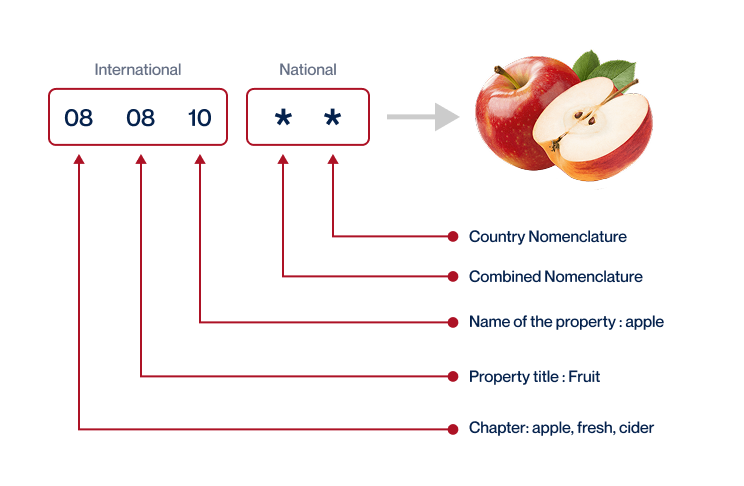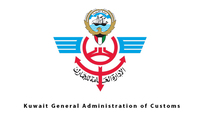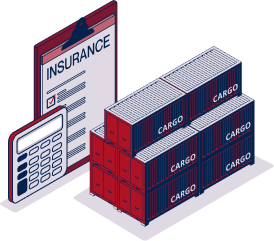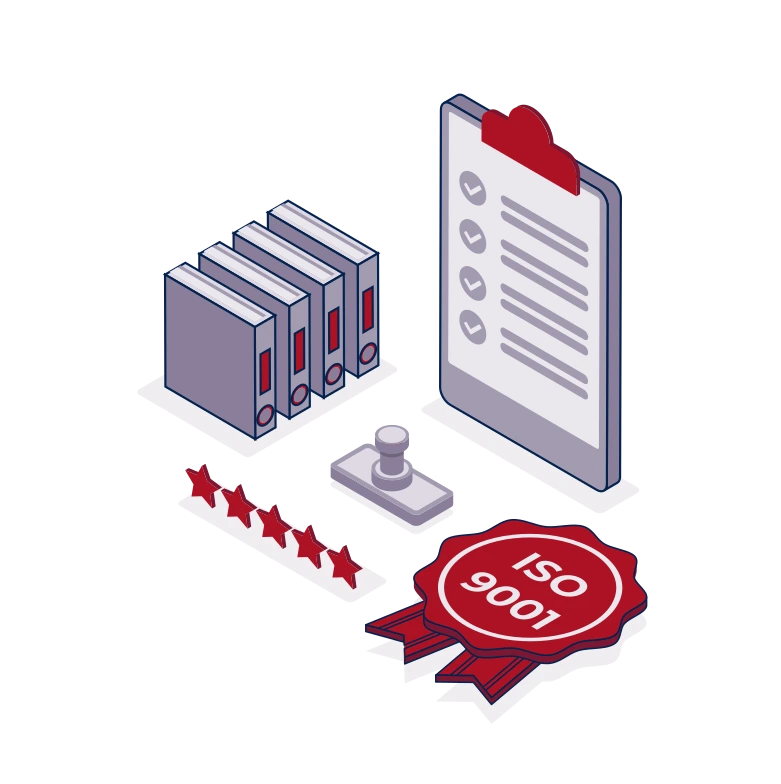Freight Shipping between Qatar and Kuwait | Rates – Transit times – Duties and Taxes
Did you know you could use a camel for your freight transport between Qatar and Kuwait? But if you're thinking speed and efficiency, those may not be your best bet.
Entrepreneurs typically struggle with the complex nature of transport rates, lengthy transit times, and a maze of customs regulations when shipping between these two destinations. This guide aims to simplify those complexities and illuminate the path forward.
It will help you to understand various freight options from air to sea, guide you through the intimidating customs clearance process, and decode the often baffling system of duties and taxes. You’ll also pick up some invaluable advice tailored specifically to meet the needs of your business.
If the process still feels overwhelming, let DocShipper handle it for you! As an international freight forwarder, we turn shipping challenges into success, managing every step of the way for your peace of mind.
Which are the different modes of transportation between Qatar and Kuwait?
Choosing the best transport option between Qatar and Kuwait should be a breeze. Picture two neighbors on the same street. They're close – no airports or sea ports separating them, just the street. That's similar to Qatar and Kuwait. These 'neighbor' countries, are linked by an efficient road network. This makes road freight a practical choice for most shipments. But remember, like each neighbour having unique house rules, these countries have their different customs procedures to follow. So, choosing the right transport option is more than just the shortest route - it's also about understanding these 'house rules’.
Need help with your shipment?
Need assistance with your shipment? Dont hesitate to contact us even for a simple question. Choose the option that suits you
Live chat with an expert Chat on WhatsApp Free Quote 24hHow can DocShipper help you

Sea freight between Qatar and Kuwait
Bridging the gap across the Persian Gulf, the bustling trade between Qatar and Kuwait is a lifeline for both nations. With container ships dancing between Hamad Port and Shuwaikh Port, these key gateways serve as thriving industrial epicenters.
Ocean freight stands as a heavy hitter when it comes to high-volume consignments despite its slower pacing; think of it like a fully-loaded freight train – not the fastest, but definitely packing a punch in terms of cargo capacity.
However, it’s no secret that journeying through the sea of shipping regulations can seem like conquering the unforgiving dunes of the Sahara for many businesses. Missteps are easy to make and can morph into costly errors. But fear not! This guide comes as your North Star, illuminating best practices to ease your voyage and ensure smooth sailing of your goods from shore to shore.
Let’s dive in to gain a new perspective on diffusing complexities, so that you can focus more on what you do best – growing your business.
Main shipping ports in Qatar
Hamad Port
Location and Volume: Located in Umm Al Houl, the Hamad Port is essential for Qatar’s economic diversification efforts and is a key point in the country’s trade, handling a shipping volume of over one million TEU per year.
Key Trading Partners and Strategic Importance: The port plays a pivotal role in connecting Qatar with key trading partners, including India, Oman, China, and Turkey. Because of its strategic location, Hamad Port serves as a crucial gateway for trade between the East and West.
Context for Businesses: If you’re looking to reach emerging markets in the Middle East region, Hamad Port could be a cornerstone of your logistics given its state-of-the-art facilities, large shipping volume capacity, and strategic location.
Ras Laffan Port
Location and Volume: Situated in Ras Laffan Industrial City in Northern Qatar, this port primarily caters to Qatar’s Liquefied Natural Gas (LNG) and petroleum industry. It’s a large port with a dedicated micro shipping network for transporting gas and petroleum products.
Key Trading Partners and Strategic Importance: Key trading partners include Gulf Cooperation Council (GCC) members and major international petroleum industry players. The strategic importance of Ras Laffan cannot be overstated, playing a pivotal role in supporting Qatar’s gas and petroleum industry.
Context for Businesses: If you are an energy company looking to establish or expand your operations in GCC countries, using Ras Laffan Port could prove fruitful, given its excellent facilities and extensive connectivity in the energy sector.
Doha Port
Location and Volume: Located in the heart of Doha, this port predominantly serves the passenger and tourism sector, although it does handle some modest cargo operations.
Key Trading Partners and Strategic Importance: Key trading partners include local businesses and GCC countries. Doha Port also plays an important role in Qatar’s burgeoning tourism and cruise industry.
Context for Businesses: If your business operates within the passenger or tourism industry, the Doha Port can be a lucrative point of operations. Developments in infrastructure are making it an increasingly popular choice for international cruise liners, facilitating your potential expansion into the Qatar tourism market.
Main shipping ports in Kuwait
Port of Shuwaikh
Location and Volume: Positioned on the Arabian Gulf in the State of Kuwait, the Port of Shuwaikh is a key focal point of trade in the region. The port handles over 700,000 TEUs every year.
Key Trading Partners and Strategic Importance: This port has strong trading connections with key global markets, with significant volume exchanges with nations like India, China, UAE, USA, and Saudi Arabia. It serves as a vital gateway for goods entering and exiting the Middle Eastern markets.
Context for Businesses: If your organization aims to capitalize on growing Middle Eastern markets, leveraging the Port of Shuwaikh could prove highly advantageous due to its well-developed infrastructure and efficient customs procedures.
Port of Shuaiba
Location and Volume: The Port of Shuaiba lies South of the Port of Shuwaikh. Primarily catering to industrial shipments, it handles approximately 500,000 TEUs per year, indicating its significant role in regional trade.
Key Trading Partners and Strategic Importance: The port has notable import and export flows with countries including Saudi Arabia, USA, China, and India. Integrated with the Shuaiba Industrial Area, it plays a critical role in facilitating industrial and specialized freights.
Context for Businesses: If your trade involves industrial raw materials or heavy equipment, including Port of Shuaiba in your logistics strategy could be pivotal, given its proximity to the industrial zone and streamlined facilities for specialized freight.
Port of Doha
Location and Volume: Located at the northern edge of the State of Kuwait, the Port of Doha has a smaller throughput, handling around 200,000 TEUs a year. However, it has a significant local importance.
Key Trading Partners and Strategic Importance: Besides maritime freight, the Port of Doha is crucial for passenger transport and has prevalent links with neighboring Middle Eastern countries.
Context for Businesses: If your shipping needs are oriented towards local markets or neighboring Middle Eastern countries, then Port of Doha should be on your radar. Its strategic location and lower crowd make it an ideal point for managing targeted and smaller scale distributions.
Should I choose FCL or LCL when shipping between Qatar and Kuwait?
When it comes to shipping goods between Qatar and Kuwait, the choice between consolidation (LCL) and full container (FCL) shipping can make all the difference. Think of it as choosing between a custom-fit suit and off-the-rack option. Your decision will greatly impact your costs, delivery times, and the overall success of your shipping process. Let’s dive deeper to understand the nuances of the two, and find the ideal shipping solution that best fits your specific needs.
Full container load (FCL)
Definition: FCL, short for Full Container Load, is a type of ocean freight where a shipper books a full container to transport goods. FCL containers come in various sizes, but commonly used ones are the 20'ft and 40'ft containers.
When to Use: Choose FCL shipping when you have enough cargo to fill a 20'ft or 40'ft container. This method is advantageous if your cargo is more than 13/14/15 CBM, thanks to economies of scale. It offers added safety, given that your goods are sealed off from origin to destination. This minimizes the risk of potential damage.
Example: Consider you're a machinery manufacturer increasing your export of heavy equipment to Kuwait from Qatar. The equipment is bulky, taking up 20 CBM per unit. For such an instance, FCL shipping is more practical and cost-effective.
Cost Implications: On the cost side, although the initial FCL shipping quote may seem high, it becomes cheaper per unit as your cargo volume increases. It's important to note that any space left unused in your FCL container is a lost opportunity, as you're paying for a full container irrespective of how much cargo you have. Therefore, proper planning is vital to maximize cost efficiency with FCL shipping.
Less container load (LCL)
Definition: LCL (Less than Container Load) shipment is a type of ocean freight transport where your cargo doesn't fill a complete shipping container. Multiple consignments from different entities are combined into a single container, making LCL a cost-effective choice for low volume shipments.
When to Use: LCL shipping is an advantageous option for shipments that won't fill up an entire container, typically less than 13 to 15 cubic meters. It's optimal for businesses that prioritize flexibility and lower costs over speed.
Example: Suppose you're a manufacturer of custom-made furniture and receive an order for a small suite of office furniture from a client in Kuwait. The cargo volume comes to just 10 CBM. Opting for LCL shipping, your furniture pieces can be shipped in a container shared with other businesses, minimizing empty, wasted space and hence costing less.
Cost Implications: The primary cost advantage of LCL freight involves only paying for the container space your goods occupy, rather than a whole container. This results in significant savings for smaller shipments. However, remember that the cost per CBM is generally higher with LCL than FCL(Full Container Load), because of the additional handling required to consolidate and deconsolidate the mixed container.
Hassle-free shipping
Ease through your cargo shipping between Qatar and Kuwait with DocShipper, your international freight-forwarding ally. Our objective? To eliminate hassles and streamline decision-making around key considerations like shipment size, cost, delivery speed, and security. Our ocean freight experts guide you to choose between consolidation or a full container, based on your unique needs. Intrigued? Tap into our expertise! Contact us today for a free estimation - let's ship smarter together.
Typically, shipping goods by sea freight between Qatar and Kuwait can take anywhere from 3 to 10 days on average. However, these transit times can vary depending on a myriad of factors such as the specific ports used, the weight and the nature of the goods being shipped.
To obtain an accurate quote tailored to your freight needs, it’s best to reach out to a trusted freight forwarder like DocShipper.
Here’s a standard table showing average transit times between the main freight ports in both countries:
| Port of Origin (Qatar) | Port of Destination (Kuwait) | Average Transit Time (Day) |
| Hamad Port | Shuwaikh Port | 5 |
| Hamad Port | Shuaiba Port | 4 |
| Ras Laffan Port | Shuwaikh Port | 3 |
| Ras Laffan Port | Shuaiba Port | 3 |
*Please note, average transit times are approximations and can change based on several logistical variables.
How much does it cost to ship a container between Qatar and Kuwait?
Determining an exact shipping cost between Qatar and Kuwait involves more variables than solving a Rubik’s Cube! Prices vary greatly, ranging anywhere from $50 to $500 per CBM.
Factors that shuffle these numbers include the Point of Loading, Point of Destination, the carrier, the nature of goods, and the unpredictable tides of monthly market fluctuations. Don’t fret, ocean freight rates are our specialty!
Our ace shipping specialists are ready to delve into the variables with you, crafting a customized quote that suits your unique shipping needs. With us in your corner, every shipment can sail smoothly toward optimum rates.
Special transportation services
Out of Gauge (OOG) Container
Definition: An OOG container is designed to transport large or heavy items that do not fit into standard containers. These are used when the cargo’s dimensions exceed the standard container size.
Suitable for: Out of gauge cargo, such as oversized generators, turbines and construction equipment.
Examples: Farm machinery, industrial equipment, windmills.
Why it might be the best choice for you: If your business deals with heavy equipment or oversized goods, an OOG container can make sure that your cargo gets from Qatar to Kuwait safely and efficiently.
Break Bulk
Definition: This refers to cargo that is too big or oddly shaped to fit into a standard container and needs to be loaded individually.
Suitable for: Large items such as timber, paper, cars, and steel beams.
Examples: Construction equipment, large pipelines, boilers.
Why it might be the best choice for you: If you need to ship loose cargo load, and the goods are too large to fit into containers, break bulk shipping is a practical and safe choice.
Dry Bulk
Definition: Dry bulk is a method used to carry goods in large quantities, such as coal, grains, or minerals, that are loaded and unloaded in a loose form.
Suitable for: Commodities prone to spoilage or deterioration if exposed to moisture.
Examples: Grains, coal, cement, fertilizers.
Why it might be the best choice for you: If you deal in large quantities of goods like grains or minerals, using dry bulk shipping methods can ensure their safe transport from Qatar to Kuwait.
Roll-on/Roll-off (Ro-Ro)
Definition: This type refers to vessels designed to carry wheeled cargo, like cars, trucks, and trailers, that are driven onto the ship on their own wheels or using a platform vehicle.
Suitable for: All types of wheeled cargo and heavy equipment.
Examples: Cars, trucks, trailers, cranes, heavy bulldozers.
Why it might be the best choice for you: If your business involves vehicle or large machinery shipping, the ro-ro vessel option is streamlined, efficient, and built specifically for your needs.
Reefer Containers
Definition: Reefer containers are refrigerated shipping containers used to transport temperature-sensitive cargo.
Suitable for: Perishable goods such as fresh food, pharmaceuticals, and any other items that need temperature control.
Examples: Fruits, vegetables, fish, medicines.
Why it might be the best choice for you: If your cargo needs to remain at a stable, cool temperature during transit from Qatar to Kuwait, reefer containers are your best choice.
Knowing your options is the key to a successful shipping operation. DocShipper understands the importance of each business’s unique shipping demands, offering customized solutions to suit your needs. Contact us today to request a free, no-obligation shipping quote and get a response in less than 24 hours.
Air freight between Qatar and Kuwait
Air freighting your goods from Qatar to Kuwait can feel a bit like a well-timed ballet: it’s swift, efficient, and if you’re transporting smaller, high-value loads, it can be wallet-friendly too.
It’s ideal for sensitive paraphernalia like electronics or pharmaceuticals that prioritize time and safety. However, several shippers often drop the ball due to insufficient planning. The misstep? Using the wrong weight formula when pricing their goods, an essential factor that could turn a promising deal on its head.
Similarly, overlooking best practices in air freight can be as punishing as leaving your umbrella at home on a rainy day. So, let’s dive deeper into these rocky waters and help you avoid some common, and costly, air freight blunders.
Air Cargo vs Express Air Freight: How should I ship?
Embarking on the journey of sending goods from Qatar to Kuwait? Deciding between air cargo and express air freight can feel like a high-stakes guessing game. Summing it up casually – air cargo is like carpooling your goods in an airline with others, while express freight is like renting your own exclusive plane for the items!
It’s all about aligning the right method with your needs. Stay tuned, as we demystify these options to make the best choice for your business.
Should I choose Air Cargo between Qatar and Kuwait?
Considering Air cargo from Qatar to Kuwait can be cost-effective and reliable, especially for cargos exceeding 100/150 kg (220/330 lbs).
Airlines like Qatar Airways Cargo and Kuwait Airways provide this service. Acknowledging their fixed flight schedules may result in longer transit times, the predictability can be useful for your logistical planning. Balancing your budget and timing needs, this option could offer the best value for your shipping requirements.

Should I choose Express Air Freight between Qatar and Kuwait?
Express Air Freight, a specialty service employing dedicated cargo planes sans passengers, can be your optimal choice when shipping between Qatar and Kuwait. For less voluminous or weighty cargo – under 1 CBM or 100/150 kg (220/330 lbs) – this method offers significant advantages.
Dynamic, time-sensitive delivery is what sets express couriers like FedEx, UPS, and DHL apart. Partnering with global couriers brings a sense of security and assurance.
Opting for Express Air Freight bolsters your shipping speed, which can prove pivotal in time-critical operations. Remember, efficient handling of your consignments is the key to a smooth, successful business transaction.

Main international airports in Qatar
Hamad International Airport
Cargo Volume: Hamad International Airport handles over two million tons of cargo annually, making it one of the region’s busiest cargo hubs.
Key Trading Partners: Major trading partners include the United Arab Emirates, the United States, China, and Germany.
Strategic Importance: Located near several major global air routes, Hamad International Airport holds critical strategic importance. Its location ensures faster transit times for cargo deliveries.
Notable Features: The airport features two parallel runways and a dedicated freight terminal capable of accommodating the world’s largest freighter aircraft. It’s also known for its technologically advanced cargo handling facilities.
For Your Business: Considering its cargo capacity, you can rely on Hamad International for high-volume shipments. Its straightforward customs protocols and extensive flight network ensure quick and smooth transitions for your goods.
Doha International Airport
Cargo Volume: Despite its decreased use since the opening of Hamad, Doha International Airport still handles impressive amounts of cargo, contributing significantly to the region’s cargo logistics.
Key Trading Partners: The key trading partners are mainly local businesses in Qatar and neighboring countries.
Strategic Importance: With its close proximity to Doha, the airport serves as an alternative in case of congestion at Hamad, providing an additional strategic value.
Notable Features: Doha International has a large cargo complex, suitable for cargo of all sizes, including oversized and heavy freight.
For Your Business: If your cargo’s destination is in Doha or the surrounding regions, Doha International Airport could be a direct, hassle-free route for your shipments.
Main international airports in Kuwait
Kuwait International Airport
Cargo Volume: Handling over 201,000 metric tons of cargo annually, playing a key role in the region.
Key Trading Partners: Primary links include the UAE, China, Saudi Arabia, India, and the US, which constitute the primary origins and destinations of cargo transferred through this airport.
Strategic Importance: Serving as a major transhipment hub in the Middle East, given its strategic location and modern cargo facilities.
Notable Features: This airport boasts a dedicated cargo terminal, state-of-the-art facilities, and excellent connectivity with major global destinations.
For Your Business: If you’re looking for a reliable and efficient cargo hub in the Middle East, Kuwait International Airport provides comprehensive cargo handling services, round-the-clock operations, and convenient custom clearances, making it an excellent choice for businesses aiming to reach markets in Asia, North America, and Europe.
How long does air freight take between Qatar and Kuwait?
The typical duration for shipping goods between Qatar and Kuwait by air freight is approximately 1-2 days. However, this transit time can fluctify, influenced by several factors including the exact airports utilized, the weight of the freight, as well as the nature of the cargo.
For accurate and specific timescales tailored to your shipment, partnering with a freight forwarder such as DocShipper is advised.
How much does it cost to ship a parcel between Qatar and Kuwait with air freight?
Shipping costs for air freight from Qatar to Kuwait vary widely, with an estimate around $3 to $10 per kg. Precise costs, however, are determined by several factors, including distance from the departure and arrival airports, the weight and dimensions of the parcel, as well as the nature of goods being shipped.
We understand these complexities, and our team is committed to providing customized quotations tailored to your specific needs. For a precise and competitive quote, contact us today. In less than 24 hours, you’ll have your free quote at hand.
What is the difference between volumetric and gross weight?
Gross weight is the total weight of your goods and any packing material. It’s simply how heavy your shipment is. Volumetric weight, on the other hand, considers the space your package occupies in the air cargo. This is vital as, in an aircraft, space can be just as important as weight.
To calculate the gross weight in air freight, you fully pack your goods and then weigh the entire package.
Let’s take an example where you’re shipping a box with dimensions of 100 cm x 50 cm x 50 cm and your fully packed box weighs 22 kg (48.5 lbs).
Volumetric weight, also known as dimensional weight, is calculated by multiplying the length, width, and height (all in cm) of your package and then dividing the result by a standard factor. In air cargo, this factor is typically 6000, while express air freight services often use a factor of 5000. In our example, the volumetric weight will be (1005050)/6000 = 41.67 kg, which equals 91.85 lbs, for air cargo. For express air freight, it would be (1005050)/5000 = 50 kg (110.2 lbs).
Understanding the concept of gross and volumetric weight is crucial since the freight charges you pay are based on the higher of these two weights. This ensures that carriers are fairly compensated not only for the weight of the shipment but also for space your shipment occupies.

Door to door between Qatar and Kuwait
Shipping your goods from Qatar to Kuwait with international door-to-door service can be a real game-changer. It’ll streamline your process by handling everything – from pickup to delivery, catering to your peace of mind. This time-saving, cost-effective option minimizes hiccups, making the whole process smooth sailing. So, let’s dive into the world of door-to-door shipping, shall we?
Overview – Door to Door
Door-to-door shipping between Qatar and Kuwait offers a seamless, stress-free logistics solution. Despite the complex customs, administrative hurdles, and transport coordination, this service handles it all, from the shipping dock to your doorstep.
Perfect for reducing the headache of shipping, it comes with its own setbacks such as slightly higher costs. However, its ease and efficiency make it DocShipper’s most sought-after service. Stay tuned to learn how you can leverage this convenience for your business despite its challenges.
This guide offers insightful and practical advice to help you manage your international freight needs with confidence.
Why should I use a Door to Door service between Qatar and Kuwait?
Who loves the adrenaline rush of handling logistics paperwork? Definitely not me, and probably not you either! That is precisely where the magic of Door to Door services comes in.
1. Say Goodbye to Stress: Door to Door services commit to picking up your goods right from your location in Qatar and delivering them to your destination in Kuwait. You don’t have to worry about the transit, freight, or complicated documentation.
2. Timely Deliveries: Urgent shipment? No sweat! With their vast network and adept operational strategies, Door to Door services ensure timely deliveries, a boon for businesses with tight schedules.
3. Special Care for Complex Cargo: If you’re shipping high-value or delicate items, the specialized handling characteristic of Door to Door services offers extra protection. Just sit back and enjoy your tea!
4. Convenience at its Best: From loading and unloading to highway trucking and customs clearance, every logistics detail is professionally handled for you. So, no more logistics headaches for you!
5. End-to-End Tracking: Wondering where your shipment is? With Door to Door services, you can track your shipment live. It’s like watching your favorite football match, except this time, your precious cargo is the star of the game!
In a nutshell, opting for Door to Door service between Qatar and Kuwait leaves you with more time, less anxiety, and some real peace of mind!
DocShipper – Door to Door specialist between Qatar and Kuwait
Trust DocShipper for hassle-free door-to-door shipping between Qatar and Kuwait! We offer expert handling of your cargo from packing and transporting to customs clearance, utilizing all shipping methods for optimized delivery. You’ll have nothing to worry about with a dedicated Account Executive at your disposal.
Request a free estimate with a swift 24-hour response, or seek advice by speaking directly to our seasoned consultants. Streamline your international shipping process with DocShipper.
Customs clearance in Kuwait for goods imported from Qatar
Customs clearance is an intricate process involving the ‘legalization’ of goods as they move across borders. Kuwait’s customs laws, especially when importing from Qatar, can be a labyrinth, replete with potential surprises like unforeseen fees.
It’s critical to grasp the varying customs duties, taxes, quotas, and potential licensing requirements to avoid your shipment from getting stalled. In the following sections, we will deep dive into this, equipping you with the knowledge to navigate these waters.
Remember, DocShipper is always on hand to guide you through this process for any goods, anywhere. Require an estimate for your project? Contact our team with the origin, value, HS Code of your goods. We’ll help you budget effectively. Curiosity piqued? Let’s dive right in.
How to calculate duties & taxes when importing from Qatar to Kuwait?
Embarking on the voyage of importing goods from Qatar to Kuwait? No need to fret! Understanding how to estimate duties and taxes can be a breeze with the right information.
It all kicks off with the meticulous task of determining the originating country of your products; one must know the country where the goods were manufactured or produced. This is crucial as it directly affects the amount of duties you’ll have to pay based on international trade agreements.
Now, you might be wondering what other factors contribute to this calculation? The puzzle pieces you need include the Harmonized System code (HS Code), the Customs Value, the Applicable Tariff Rate, and other possible taxes and fees of your products. Use them in conjunction, and voila! You’ll have your estimate.
Just remember, your first step is to have your goods’ nation of manufacture or production spot on. Now, get ready to become a whiz at unravelling the customs duties mystery and get your cargo moving seamlessly from Qatar to Kuwait!
Step 1 – Identify the Country of Origin
Identifying the Country of Origin for your goods is a foundation stone to accurately estimate duties and taxes when importing from Qatar to Kuwait. Here’s why:
1. Country-based Trade Agreements – Specific arrangements are in place between Qatar and Kuwait, which impact your tariff rates. You must scrutinize these trade agreements to maximize benefits.
2. Import Restrictions – Certain items have restricted entry under the laws of Kuwait. You must verify your goods’ eligibility and observe regulatory compliance.
3. Customs Duty Calculation – Duties often differ based on the origin. Knowing your products’ origin allows accurate computation of any applicable duties.
4. Verification of Documents – Origin information enables seamless verification of legal documents and certificates, smoothing out the customs clearance process.
5. Fraud Protection – Accurate origin representation safeguards against fraudulent practices and prevents penalties.
Ensure you delve into the above points to optimize shipping costs and circumvent potential legal complications. Remember that seemingly negligible details could result in crucial cost and time savings and keep your international shipping on the right track.
Step 2 – Find the HS Code of your product
The Harmonized System (HS) code is a globally recognized classification method for traded goods. It establishes a standardized numerical method for identifying products, which simplifies international trade. Used by more than 200 countries, it forms the basis for Customs tariffs and the collection of international trade statistics.
One easy way to find the HS code of your product is to ask your supplier directly. They’re usually familiar with the products they’re importing and the associated regulations. But don’t worry if this isn’t an option for you – the process can be broken down into simple steps.
To locate an HS code by yourself, you’ll need to use an HS lookup tool. The Harmonized Tariff Schedule (HTS) is a reliable tool you may consider. It allows you to search for your product by name and find the corresponding HS code in the Heading/Subheading column.
Your first task is to navigate to the Harmonized Tariff Schedule. In the search bar at the top, input the name of your product. Then, on the page that opens, search the Heading/Subheading column. Here, you’ll be able to find the most accurate HS code for your goods.
Remember, precision is key in choosing your HS code. A wrong code can lead to unwanted delays and could even incur fines. Therefore, taking the time for this task is essential to smooth transport and customs procedures.
Here’s an infographic showing you how to read an HS code.

Step 3 – Calculate the Customs Value
You’re immersed in a pulsating trade opportunity from Qatar to Kuwait and puzzling over customs value? Let’s demystify this! While the product price and customs value may appear similar, they have distinctions that directly affect your pocket. Customs value isn’t just the price tag on your product. It’s a more encompassing figure termed ‘Cost, Insurance, and Freight (CIF),’ and it’s calculated in USD.
The CIF’s more holistic view lumps together 3 key components: your goods’ price, international shipping cost, and insurance. Say, your goods cost $5000, you paid $1000 for shipping and $500 for insurance – here, the CIF customs value would be $6500.
Understanding the customs value is crucial as it significantly impacts your import duties and taxes. So, next time you calculate the customs value, remember: it’s about being aware of all your costs! That’ll bring you closer to a smooth journey from Qatar to Kuwait.
Step 4 – Figure out the applicable Import Tariff
An import tariff, simply put, is a tax imposed on goods imported into a country. The type of tariff used in Kuwait is predominantly ad valorem, assessed as a percentage of the total value of the goods being imported.
Here is how you can identify the applicable import tariff for goods coming from Qatar to Kuwait:
1. Take note of the Harmonized System (HS) code that was identified earlier in the guide. This will be key to finding the correct import tariff. Assume, for example, the HS code is 0101.12 which corresponds to Live pure-bred breeding horses.
2. Research the specific tariff schedule for Kuwait. You will need to consult the customs department or the Ministry of Commerce and Industry’s website.
3. Enter the HS code along with the country of origin and check for the corresponding import tariff.
Assume the tariff for HS code 0101.12 is 5%. Now, let’s calculate the import tax. If the goods, insurance, and freight (CIF) cost is $10,000 USD, the import duty will be 5% of $10,000, which equals $500. Therefore, the total amount to be paid at customs would be the CIF cost plus the import duty, leading to a total of $10,500.
Remember, timely and accurate declaration of your goods is crucial to avoid any unnecessary delays or charges in the clearance process.
Step 5 – Consider other Import Duties and Taxes
Once you’ve dealt with the standard tariff rate, be aware of potential additional import duties based on the item and its origin. Excise duty, anti-dumping taxes, and Value Added Tax (VAT) could all apply.
Suppose you’re shipping stainless steel products. An excise duty may apply (let’s say it’s a hypothetical 5% of the item value). And if the product is dropped in price to undercut the local market (deemed ‘dumping’), an anti-dumping tax might be charged as well (perhaps an extra 10%).
However, it’s the VAT that often surprises; it’s a broad-based tax on consumption and adds to the product’s final price. In Kuwait, it’s typically around 5%. So, if your product value is $500, the VAT alone could be $25.
Remember, these are illustrative figures only. Your actual duties and taxes will depend on specific circumstances and current rates. Staying on top of these potential complexities can ensure a smoother import process, saving your business time and money. It’s always worthwhile getting professional advice or using dedicated tools to estimate these costs accurately. That way, you’ll avoid unwanted surprises and keep your imports rolling in without a hitch.
Step 6 – Calculate the Customs Duties
Calculating customs duties when shipping goods from Qatar to Kuwait requires specific formulae. The customs duty is typically a percentage of the customs value, which includes the cost of the goods, freight, and insurance.
For example, assume a product with a customs value of $1000 and a duty rate of 5%, the customs duty would evaluate as $1000 x 5% = $50. This calculation assumes no VAT is involved.
Now consider if VAT comes into play. VAT (Value Added Tax), often charged on the total value of the goods along with duties, is calculated by adding the customs value and the duty. So, if VAT in Kuwait is 5%, the total tax would be (customs value + duty) x VAT = ($1000 + $50) x 5% = $52.50. Hence, the combined duty and VAT would sum up to $102.50.
Lastly, contemplate a situation involving anti-dumping taxes and Excise Duty. Add these values to the previous total calculation. For example, if the anti-dumping tax is $20 and Excise Duty is $30, the final sum would be $102.50 + $20 + $30 = $152.50.
Keep in mind, precise calculation of customs duties could be daunting. DocShipper eliminates this hassle by taking care of every step in your customs clearance process around the world, making sure you pay only what’s necessary. Contact us for a free quote in less than 24 hours.
Does DocShipper charge customs fees?
Among shipping costs, it is crucial to differentiate between customs duties and customs clearance fees. As a custom broker in Qatar and Kuwait, DocShipper doesn’t charge any customs duties – that’s a governmental domain! Instead, we handle customs clearance and its accompanying fees.
Think of it like a service fee for navigating the complex customs process on your behalf. To maintain transparency, we provide documents from the customs office showing the exact charges applied, so you only pay what’s necessary. With us, you avoid any unwarranted surprises in your international shipping journey.
Contact Details for Customs Authorities
Qatar Customs

Official name: General Authority of Customs – State of Qatar Official website: https://www.customs.gov.qa/
Kuwait Customs

Official name: General Administration of Customs in Kuwait Official website: https://www.customs.gov.kw/
Required documents for customs clearance
Understanding the paperwork for customs can surely be a headache. Let’s break it down, as we tackle the importance of the Bill of Lading, Packing List, Certificate of Origin, and Conformity documents. Here’s your go-to resource for streamlining your shipping and avoiding delays or penalties.
Bill of Lading
Navigating the waters of international freight between Qatar and Kuwait? Familiarize yourself with the crucial document that sets sail to your goods: The Bill of Lading.
Acting like a passport for your cargo, the Bill of Lading is a binding contract between you and the carrier, marking the transition of ownership once signed. Imagine shipping a cargo of automotive parts – without this document, your shipment might be stuck at the port. Opting for an electronic, or ‘telex’ release, provides a faster dispersion, more safety, and can solve dilemmas like lost or late original documents.
For those dealing with air cargo, remember the Air Waybill (AWB) plays a similar role. It’s all about timely delivery, safety, and smoothening your business operations, so keep up with these documents for a smooth ride in international shipping!
Packing List
When shipping goods from Qatar to Kuwait, your Packing List is your best friend. This essential document outlines exactly what is in your shipment, with detailed descriptions such as weights and dimensions.
Whether you’re shipping pallets of ceramic tiles by sea, or a consignment of perfumes through air freight, it’s your responsibility as a shipper to ensure this document is spot on. Its role is akin to the narrator of a tale; a mismatch in reality and document details can result in customs delays, or even refusal.
So imagine you’re telling a story of your shipment, where omittance or exaggeration could jeopardize your entire shipment’s journey. So, assess each item precisely before declaring. It’s your truth teller, your assurance for your goods’ seamless passage from bustling Doha to vibrant Kuwait City.
Commercial Invoice
A Commercial Invoice is your lifeline when shipping goods from Qatar to Kuwait. This document is a record of all the details about your shipment, including description, quantity, and value of goods to name a few.
It acts as a catalyst for smooth customs clearance. Consistency is key, ensuring information aligns with other shipping documents – discrepancies lead to delays or penalties. For example, if you’re shipping 500 kgs of automotive parts, each part’s specific details should uniformly appear in your Packing List and Bill of Lading too.
Keep everything transparent, precise, and avoid jargon to ensure customs officials in both countries comprehend your document easily. It’s a simple action that can save your business both time and unnecessary stress.
Certificate of Origin
Navigating customs between Qatar and Kuwait? You won’t get far without a Certificate of Origin. This essential piece of paper validates where your goods were crafted, impacting duties drastically. Let’s say your manufacturing hub is in Doha, producing automotive parts.
When shipping to Kuwait, a correctly filled Certificate of Origin pinpoints Qatar as the manufacturer country, potentially unlocking preferential duty rates, saving your business big bucks. And who doesn’t love a good cost-cutting measure? Got the origin wrong? Prepare for a customs headache. Right product, wrong origin can lead to delays, hassle, and even fines. Always double-check and ensure your Certificate of Origin is accurate to avoid any potential pitfalls.
Get Started with DocShipper
Prohibited and Restricted items when importing into Kuwait
Ensuring your shipment complies with Kuwait’s import regulations isn’t just a legal necessity. It’s key to avoiding frustrating delays, hefty fines, or even the seizure of your goods. Understanding prohibitions and restrictions saves you trouble down the line. Let’s dive into Kuwait’s import rules.
Are there any trade agreements between Qatar and Kuwait?
Yes, indeed, there are trade agreements between Qatar and Kuwait. Being part of the Gulf Cooperation Council (GCC), they benefit from free trade amongst member countries. This means simplified customs procedures and zero tariffs on goods, which could reduce your export-import costs significantly.
In addition, infrastructure projects like the GCC Railway Network are under consideration, which, once completed, could facilitate faster and economical road transport between the two countries.
Qatar – Kuwait trade and economic relationship
Located on the Arabian Peninsula and steeped in a shared cultural history, Qatar and Kuwait hold a steady economic tie. This relationship came into prominence in the 1970s with their first oil reserves discovery and has since progressed invariably, powered by mutual investments, substantial trade exchanges, and collaborations across key sectors like oil, gas, construction, and finance.
The Qatari-Kuwaiti Joint Economic Commission, established in 2015, has further fostered collaborative business ventures and boosted the trade volume which was reported at over $864 million in 2022. Predominantly, natural gas exports from Qatar and non-oil goods trade from Kuwait form the major chunk of this volume.
Notwithstanding the fluctuations in global oil prices, the mutual investments between the two nations stand robust, contributing significantly to their respective GDPs, attesting to the strength and potential of their economic kinship.
Your first steps with DocShipper
Additional logistics services
Warehousing
When shipping Qatar to Kuwait, reliable storage solutions are crucial! Imagine the havoc a poor temperature-controlled warehouse can wreak on sensitive goods. Got artisanal chocolates melting, or machinery rusting? Despair not! Quality warehousing that keeps your goodies safe is just a click away.
Packing
Efficient packaging is crucial when shuttling goods between Qatar and Kuwait. To survive the voyage, your cargo needs protection. This is where our ace packaging/repackaging service steps in. Think fragile art pieces swathed in strong materials, or machinery parts in custom-built wooden crates. Having a reliable ally in this process ensures your items reach their destination in perfect condition.

Transport Insurance
Harnessing cargo insurance can be a vital safety net during the transit process. Unlike fire insurance, which only covers loss from fiery damage, transport insurance safeguards against a wider range of unprecedented incidents. Imagine if your shipment gets damaged during offloading, or lost at sea. With cargo insurance, such risks are substantially mitigated, offering you peace of mind and financial protection.

Household goods shipping
Shipping personal effects from Qatar to Kuwait? Trust us to handle your delicate and oversized items with utmost care. Whether it's a cherished heirloom or an exotic piece of furniture, our skilled team ensures it reaches your destination safely. Just like we recently did for a Qatari art collector, moving his valuable canvases to a new Kuwaiti gallery, your treasured possessions are always in safe hands. Our flexibility guarantees your stress-free move.
Procurement in Thailand
Expanding into Kuwait or Qatar? DocShipper makes it a breeze. We help you partner with the right suppliers in Asia and Eastern Europe, eliminating language hiccups and streamlining procurement. Imagine, no more guessing games, just efficient sourcing bolstered by our skillful guidance. Let's unlock new horizons together!

Quality Control
Ensuring your goods meet standards is critical when shipping from Qatar to Kuwait. Quality control inspections in early stages can help avoid costly customs issues or returns. For example, an electronics company discovered a faulty component during QC checks, saving them the headache of dealing with customs and angry customers received properly functioning gadgets.

Conformité des produits aux normes
Avoid seized shipments by ensuring your goods adhere to specific market regulations. Our Product Compliance Services help you eliminate guesswork with laboratory testing for certification. Stay confident as your products glide through customs, all set up for a successful entry in their new market. Let us handle the intricate nuances of country-specific regulations so your business never misses a beat.






